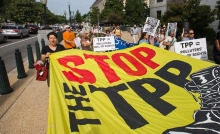Why TPP is a bad deal for America and American workers

By Joseph Stiglitz
Yes, economic gains can be found through trade liberalization where trade barriers are high, but tariffs are already low (just 2.7 percent on average between TPP member countries). Put this minuscule number next to the surging U.S. dollar, up 26 percent since July 2011. A more expensive dollar makes imports cheaper and exports less competitive in foreign markets. The exchange rate change swamps the benefits from the small reduction in tariffs. And the toothless side declaration on exchange rate misalignments by TPP finance ministers is likely to be as ineffective as current diplomatic efforts to rebalance exchange rates.
While the U.S. Trade Representative boasts of 18,000 tariff cuts for American exporters, the economic significance of many of these to U.S. producers and workers appears negligible. For example, tropical, impoverished Vietnam will eliminate tariffs on skis, snowplows, and caviar, while predominantly Muslim Brunei and Malaysia will eliminate tariffs on pork. In fact, in more than half of the 18,000 categories, the U.S. exported nothing to TPP nations last year; for many of the remaining 7,500 categories, American exporters sold only small amounts. These are areas where American producers are unlikely to develop a comparative advantage.
With trade barriers already so low, it is no wonder that existing modeling analyses from economists at the Peterson Institute and the World Bank show such negligible benefits from eliminating trade barriers in TPP. Both find that gains to the U.S. economy will be less than the statistical error when the Commerce Department calculates our GDP figures. A study by the Economic Research Service found that TPP would have zero effect on U.S. GDP.
Even these estimates should be taken with a grain of salt: The models assume that trade will be balanced and no unemployment will ensue. Models incorporating more realistic assumptions, like those from economists at Tufts University, find a net GDP loss for the United States from TPP.
We know that imports displace U.S. jobs while exports create them. But even if trade grew in balance, there is reason to expect the U.S. would shed more jobs in the labor-intensive industries hit by import competition than it would gain in the capital-intensive industries where U.S. exports may expand, causing net unemployment to rise. Empirical research, as opposed to simulations in theoretical models, shows that import surges result in significant job dislocations and wage declines in the U.S. — not just for those directly affected, but across entire regional economies as demand falls and more workers compete for lower-quality jobs.
Past experience gives no reason to believe new agreements will help balance trade, bringing our exports more in line with our imports. For example, the U.S. International Trade Commission predicted that the U.S.–Korea free trade agreement, implemented in 2012, would narrow the $13 billion U.S. trade deficit with Korea by $4 billion. Instead, in the most recent 12-month period, the trade deficit with Korea expanded to more than $29 billion.
The most significant parts of the TPP pertain to investment, not trade. But these investment provisions make it more attractive for American businesses to move jobs and production offshore and give greater credibility to the offshoring threats employers use to undercut U.S. workers’ demands for higher wages and unions.
It is possible to write a trade agreement that is fair to workers and provides broadly shared benefits for all Americans. But when people other than those representing the interests of big businesses are shut out of writing the rules of the economy, that outcome is unlikely.
President Obama once declared that the inequality jeopardizing America’s middle-class society is “the defining challenge of our time.” He should be fighting for a trade agreement that creates jobs and growth — a quite different agreement from the TPP, which will most likely create more economic pain and hardship for America’s working families and small businesses.
Joseph E. Stiglitz is Senior Fellow and Chief Economist at the Roosevelt Institute and a professor at Columbia University. A recipient of the Nobel Memorial Prize in Economic Sciences (2001) and the John Bates Clark Medal (1979), he is a former senior vice president and chief economist of the World Bank and a former member and chairman of the (US president’s) Council of Economic Advisers. This is part one of an op-ed series being released by Professor Stiglitz in conjunction with the Roosevelt Institute.

